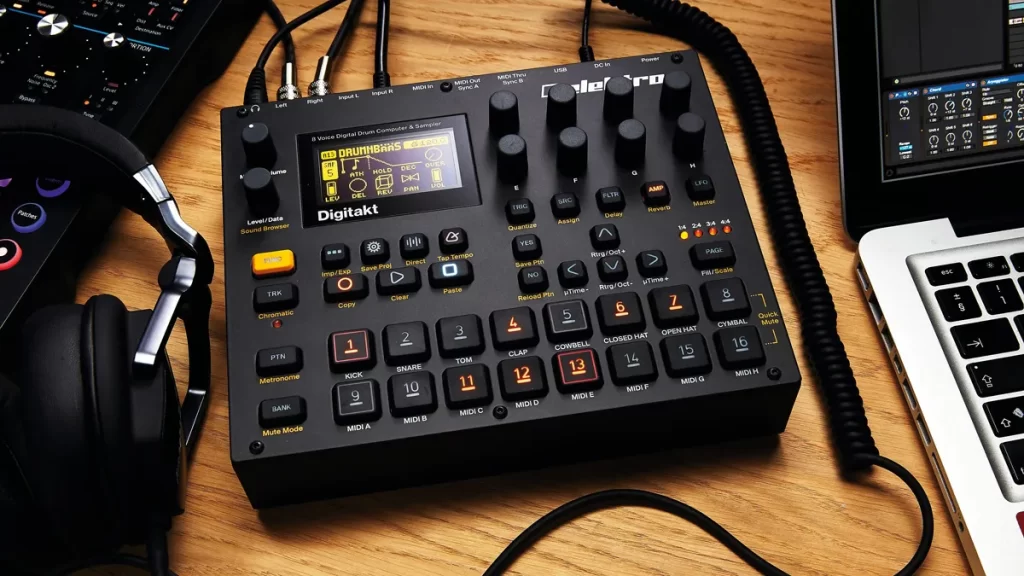A sampler is an electronic or digital device that records, manipulates, and plays back audio samples. These samples can be sounds from any source, such as musical instruments, vocals, nature sounds, or any other audio. Samplers are a fundamental tool in modern music production, sound design, and audio engineering. Here is a Gear News feed on what is happending in the world of samplers.

Key Features of a Sound Sampler
- Sampling:
- Recording: The primary function of a sampler is to record audio samples. This can be done via an external microphone, line input, or by importing digital audio files.
- Sample Rate and Bit Depth: Samplers record audio at various sample rates (e.g., 44.1 kHz, 48 kHz) and bit depths (e.g., 16-bit, 24-bit), which affect the quality and fidelity of the recorded sound.
- Playback:
- Triggering: Samplers can play back recorded samples using various triggers, such as MIDI controllers, keyboard keys, pads, or sequencers.
- Looping: Samples can be looped to create continuous sounds, which is useful for background tracks, drum loops, and ambient sounds.
- Editing:
- Cutting and Trimming: Samplers allow users to edit samples by cutting, trimming, and adjusting the start and end points of the sound.
- Pitch Shifting and Time Stretching: Users can change the pitch of a sample without affecting its duration and vice versa, enabling creative manipulation of the sound.
- Effects and Processing:
- Filters: Apply various filters (e.g., low-pass, high-pass) to shape the sound.
- Envelopes: Control the amplitude of the sample over time with ADSR (Attack, Decay, Sustain, Release) envelopes.
- Modulation: Use LFOs (Low-Frequency Oscillators) and other modulation sources to alter the sample’s parameters over time.
- Memory and Storage:
- Internal Memory: Some samplers have built-in memory to store samples.
- External Storage: Many samplers use external storage like SD cards, USB drives, or computers for additional sample storage and organization.
Types of Samplers
- Hardware Samplers: Here’s a good example of diiferent units on the market.
- Standalone Units: These are dedicated devices designed specifically for sampling and playback, such as the Akai MPC series or the Elektron Octatrack.
- Workstations: Many modern synthesizers and music workstations include built-in sampling capabilities.
- Software Samplers:
- DAW Plugins: Many digital audio workstations (DAWs) include software samplers as part of their suite, such as Ableton Live’s Simpler and Sampler, or FL Studio’s DirectWave.
- Standalone Software: Independent software applications like Native Instruments’ Kontakt, which offer extensive sampling and sound design capabilities.
Uses of Samplers
- Music Production:
- Beat Making: Samplers are heavily used in hip-hop, electronic, and pop music for creating beats and backing tracks.
- Instrument Emulation: They can replicate the sounds of various instruments, allowing musicians to use sampled pianos, strings, drums, etc., in their compositions.
- Sound Design:
- Film and Game Audio: Samplers are used to create and manipulate sounds for movies, television, and video games.
- Experimental Music: They provide tools for experimental and avant-garde music, where unique sound manipulation is desired.
- Live Performance:
- DJing and Live Sets: Samplers are used by DJs and live performers to trigger samples, loops, and effects during their performances.
- Education and Research:
- Learning Tool: Samplers are used in educational settings to teach music production and sound engineering.
- Audio Research: They are employed in research projects involving audio analysis and synthesis.
Samplers have revolutionized the way music and sound are created, allowing for unprecedented flexibility and creativity in audio production.
For more information on the best samplers currently on the market head to these page or look at some budget options here.
